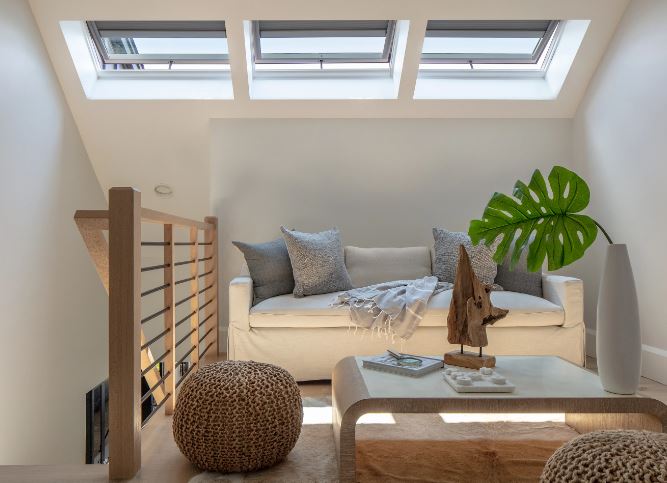How To Add a Skylight To Your Home
The benefits of a skylight
Natural light in your home provides numerous benefits that go beyond simply brightening up your space.
Adding a skylight to your home can be a great way to bring in natural light and enhance the overall ambience of your space. Here are the general steps involved in adding a skylight:
Assess Feasibility: Start by evaluating whether your home’s roof structure and layout allow for the installation of a skylight. Consider the roof pitch, nearby obstructions (such as chimneys or vents), and the structural integrity of the roof. It’s advisable to consult with a professional contractor or architect to determine the feasibility of adding a skylight and any potential structural modifications required.

Choose the Right Skylight Type: There are various types of skylights available, including fixed, vented, tubular, and electrically operated skylights. Each type has its own features and benefits, so choose one that suits your needs, budget, and the architecture of your home.
Obtain Permits and Regulations: Before proceeding, check with your local building department to determine if you need any permits or if there are specific regulations regarding skylight installation. Complying with local codes ensures that the installation is safe and meets the necessary requirements.
Hire a Professional Contractor: Unless you have experience in roofing and construction, it’s recommended to hire a professional contractor who specializes in skylight installations. They will have the expertise and equipment to ensure proper installation, sealing, and waterproofing.
Select the Skylight Location: Determine the ideal location for the skylight based on the room’s layout, desired light distribution, and architectural considerations. Consider factors like the angle and intensity of sunlight at different times of the day to minimize excessive heat or glare.
Prepare the Roof Opening: The contractor will measure and mark the location for the skylight on the roof. They will then carefully remove shingles or tiles and cut an appropriate-sized opening in the roof, following the manufacturer’s guidelines.
Install Flashing and Weatherproofing: Proper flashing and weatherproofing are crucial to prevent leaks and ensure the skylight is properly sealed. The contractor will install the flashing around the skylight opening, followed by a waterproof membrane to protect against moisture infiltration.
Install the Skylight: With the flashing and weatherproofing in place, the contractor will position and secure the skylight into the roof opening. They will ensure it fits tightly, apply sealants, and fasten it according to the manufacturer’s instructions.
Insulate and Finish: The contractor will insulate the area around the skylight to maintain energy efficiency and thermal comfort. They will then install the appropriate interior finishing materials, such as drywall or trim, to complete the skylight installation seamlessly.
Test and Maintain: Once installed, the skylight should be tested for proper functionality and any signs of leakage. Regular maintenance, including checking for debris or damage, keeping the skylight clean, and inspecting the seals, is important to ensure its longevity and performance.
Remember, skylight installation can be complex and requires professional expertise to ensure it is done safely and correctly. Hiring a reputable contractor will help you achieve the best results and minimize potential issues.
7 good reasons for having a skylight to brighten up your house –
- Health and Well-being: Exposure to natural light has a positive impact on your overall health and well-being. It helps regulate your circadian rhythm, the body’s internal clock that controls sleep-wake cycles, hormone production, and other essential bodily functions. Natural light exposure during the day can improve your sleep quality, boost your mood, increase energy levels, and reduce the risk of conditions like seasonal affective disorder (SAD).
- Vitamin D Production: Sunlight is a primary source of vitamin D, which plays a crucial role in maintaining strong bones, regulating the immune system, and improving mental health. By allowing natural light into your home, you can help your body produce this vital nutrient.
- Improved Productivity and Focus: Natural light has been shown to enhance productivity and focus. Studies indicate that exposure to daylight in work or study environments can lead to increased concentration, improved cognitive function, and enhanced productivity. Natural light creates a more pleasant and stimulating atmosphere, reducing eye strain and fatigue commonly associated with artificial lighting.
- Energy Savings: Incorporating natural light into your home design can significantly reduce the need for artificial lighting during the daytime. This, in turn, can lead to substantial energy savings and lower utility bills. Additionally, by relying less on artificial lighting, you decrease your carbon footprint and contribute to a more sustainable lifestyle.
- Enhanced Aesthetics and Visual Appeal: Natural light has a unique quality that can enhance the aesthetics of your living space. It brings out the true colors of your decor, artwork, and furnishings, creating a more vibrant and visually pleasing environment. Natural light also helps make your space feel more open, spacious, and inviting.
- Connection with the Outdoors: Natural light connects you with the natural world outside, providing glimpses of the changing seasons, weather conditions, and the beauty of nature. This connection can have a positive impact on your mental well-being, fostering a sense of calmness, tranquility, and harmony with your surroundings.
- Increased Resale Value: Homes with ample natural light are often more appealing to potential buyers. The presence of natural light is considered a desirable feature that can increase the resale value of your property.



